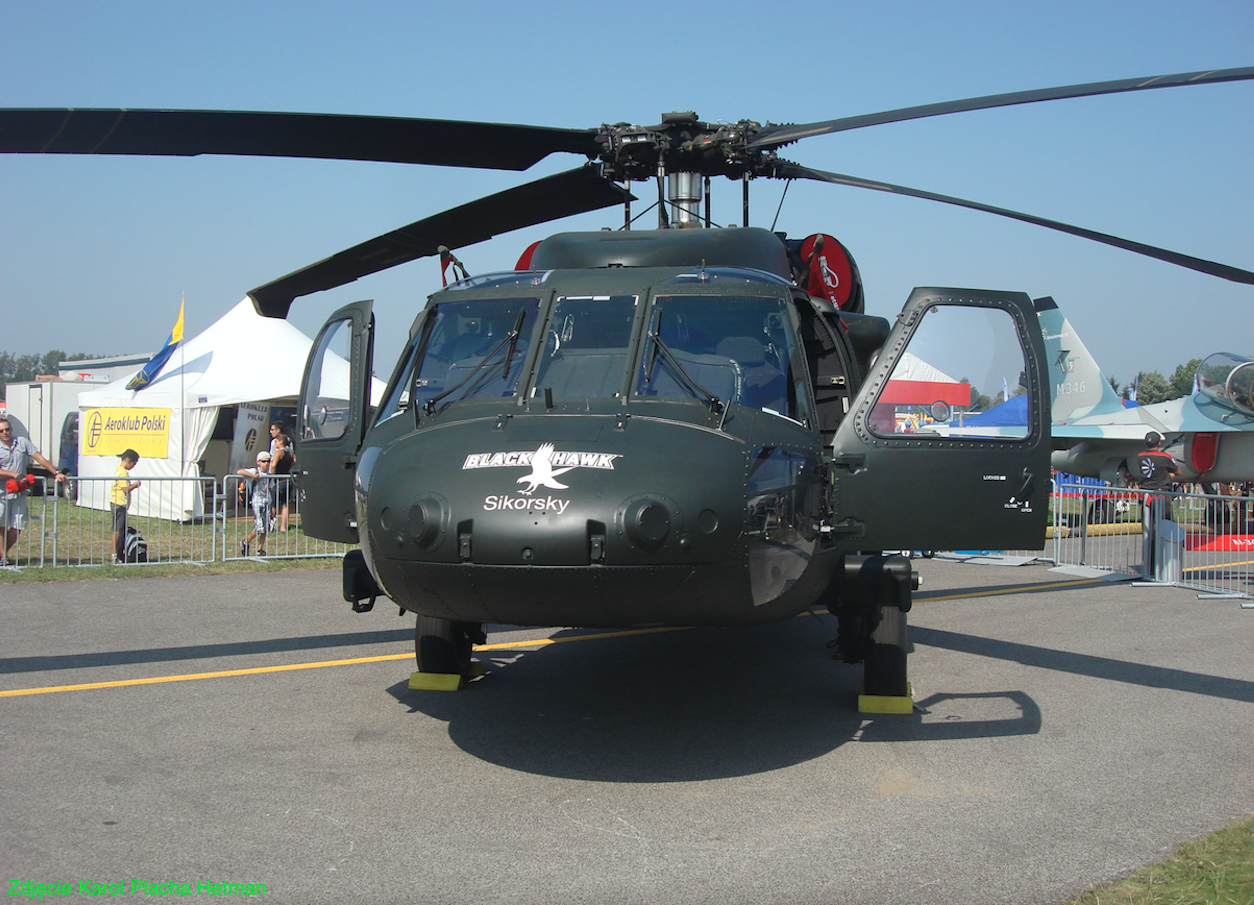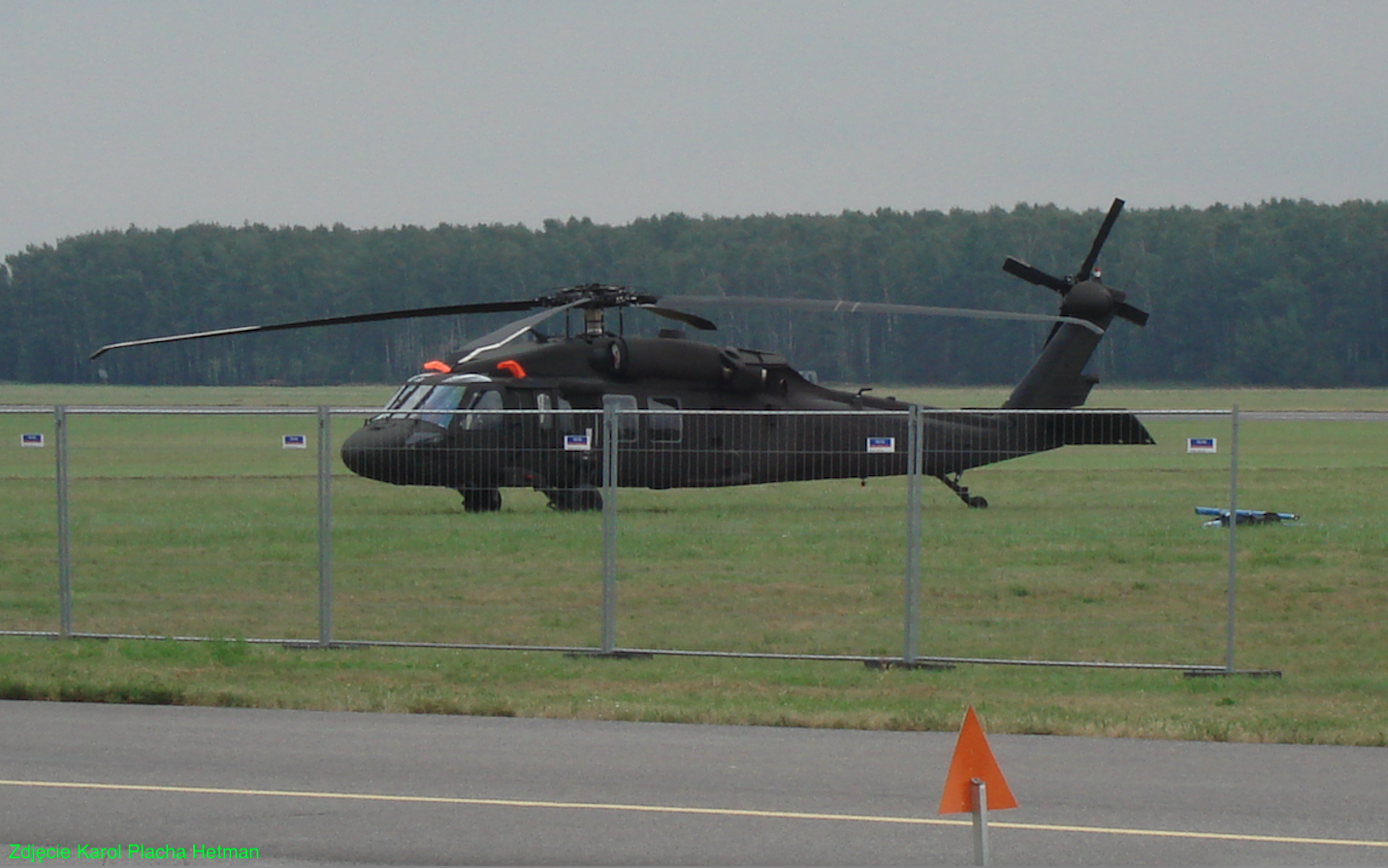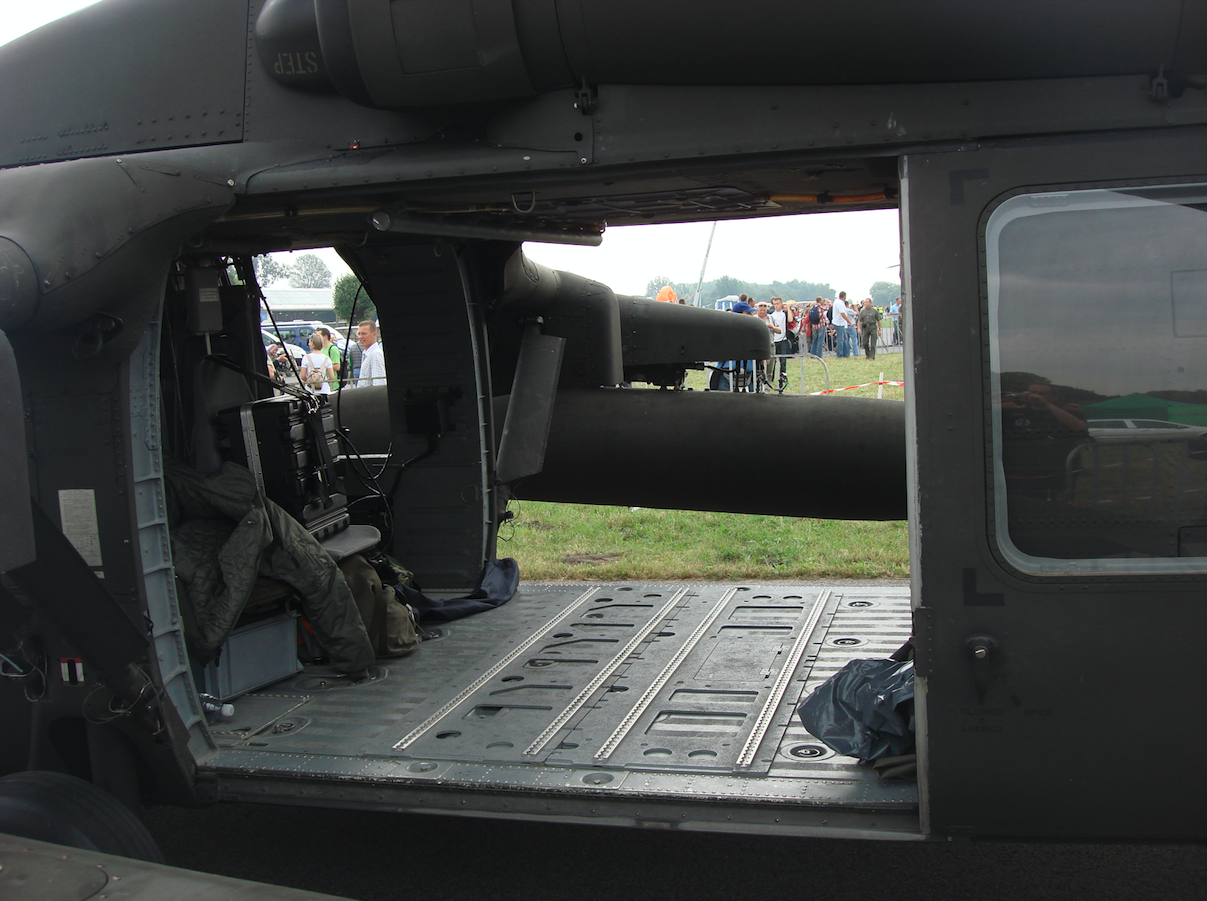Mielec 2010-04-19
Sikorsky-Mielec Black Hawk S-70i
317b Section 15.03.2010 year. Poland.
The Black Hawk helicopter is one of the most recognizable helicopters in the world. The Black Hawk S-70i helicopter is currently manufactured in Mielec, in the former PZL plant. The Black Hawk multi-role helicopter is in service with the U.S. Army and 28 other nations around the world as a rugged, reliable utility helicopter.




The history of the Black Hawk helicopter design.
The Vietnam War shaped views on the use of helicopters on the battlefield. For the first time, an Air Cavalry unit was organized in the USA, whose primary means of transport and combat were multi-purpose helicopters. The most commonly used machine at that time was the Bell UH-1 Iroquois (Huey) helicopter. Already at the beginning of the 1960s, it did not meet the growing requirements of the army. The command of the US Army in the period 1965-1971, developed the assumptions specified UTTAS (Utility Tactical Transport Aircraft System). On January 5, 1972, a contest was announced. The following companies entered the competition: Boeing Vertol, Sikorsky Aircraft. Due to the strict requirements, both structures were similar to each other. This is how the Sikorsky S-70 / YUH-60 A Black Hawk helicopter was created.
The Sikorsky S-70 is an American family of medium transport and utility helicopters, manufactured by the Sikorsky Aircraft concern. The helicopter was developed for the US military in the 70s, winning the competition and was designated the UH-60 Black Hawk and created a large family of machines in US military service. New and improved versions of the UH-60 have since been developed. Civilian versions and some military versions are produced under different S-70 model designations.
Over the past 40 years, this remarkable helicopter has operated in many combat areas to deliver and evacuate troops, save lives, as a MEDEVAC or conflict evacuation platform, deliver essential supplies to troops, and deliver essential supplies during natural disasters. It acts as an aerial firefighter and is used to patrol borders.
Currently (2010), the modern variant of this utility helicopter takes on a new set of missions - as an armed helicopter that provides suppression of enemy fire when supporting ground troops, as well as creating an armed escort. Thanks to digital avionics, powerful General Electric engines, high-strength airframe construction and composite wide blade rotor blades, today's Black Hawk platform has better survivability, total situational awareness, can fly higher and carry more payload than its predecessors.
More than 4,000 Black Hawks of all types are in service around the world today. The US Army is the largest operator with 2,135 H-60s. This helicopter is exported internationally directly from Sikorsky under the designation S-70.
The S-70 family of helicopters was developed to meet the US Army's requirement to replace the UH-1 Iroquois family of medium-sized helicopters. Work started in 1972. Utility Tactical Transport Aircraft System (UTTAS) program – tactical air transport system. Three prototypes (+ two for ground trials) of the S-70/YUH-60A were built and first flew on 17 October 1974. The competitor was the Boeing-Vertol YUH-61A design. The competing machine YUH-61 was flown on November 29, 1974.
In the spring of 1976, the army began test flights. Each company delivered 3 helicopters. In virtually every respect, the YUH-60 was superior to its competitor, the YUH-61. It had a higher rate of climb, maximum speed, lower curb weight, lower operating costs, and a higher level of safety for the crew. The YUH-61 A helicopter had only a better rotor, the so-called semi-rigid, composite, built under the license of the MBB company from West Germany.
The result of the competition was announced on December 23, 1976. The winner was the YUH-60A and was directed to serial production and entered service as the UH-60A Black Hawk with the US Army in 1979. The UH-60 made its first flight on October 17, 1978.
The first order, in December 1976, included 15 machines, followed by another 368 machines in the spring of 1977, with a deadline for completion by the end of 1981. The first UH-60A helicopter was delivered to the US Army on October 31, 1978. On June 19, 1979, the first UH-60A helicopter was delivered to a training facility in Alabama. The first operational unit was the 101st Air Cavalry Unit at Fort Cambell, Kentucky. In April 1982, another large order was received for 294 machines with a delivery time until the end of 1985. The value of the contract is $950 million.
The first military operation for the UH-60 was the American intervention in Grenada in 1983. Helicopters transported invasion troops from the aircraft carrier Guam to the island. The UH-60 turned out to be very good. One of the UH-60s returned to base with many holes from artillery fire.
After entering service, the helicopter was modified for new missions and tasks, including minelaying and medical evacuation. The EH-60 variant was developed for electronic warfare. Variant of the MH-60 for aviation special operations and support of other missions. At the end of the 1980s, the model was upgraded to the UH-60 L, which received new, more powerful General Electric T700-701C engines.
The improved UH-60 M model was developed in the early 2000s. The UH-60 M and its international version, the S-70i, feature GPS navigation, a glass cockpit, an integrated flight management system, and a major upgrade to the propulsion system and rotor adding both power and payload capability.
Several S-70 helicopters are used to transport the president of the United States, which is nicknamed "Marine One" when carrying the president.
In assault operations, the Black Hawk machine can carry 20 people, a squad of 11 armed soldiers or a 105 mm M102 howitzer, thirty rounds of ammunition and a crew of six. Alternatively, it can carry 2,600 lb (1,200 kg) of cargo or 9,000 lb (4,100 kg) sling load.
The US Navy received the first customized SH-60 B Seahawk (Sea Hawk) in 1983, and the SH-60 F Ocean Hawk in 1988.
The HH-60 G Pave Hawk is a highly modified version of the S-70 helicopter, primarily designed to rescue the crew of downed aircraft or other isolated personnel during war or conflict. It is equipped with a winch with a 250-foot (76 m) rope that has a lifting capacity of 600 pounds (270 kg). The helicopter has a retractable probe for in-flight refueling. The US Air Force received the MH-60G Pave Hawk in 1982. The US Coast Guard received the HH-60J Jayhawk in 1992.
The S-70 A Firehawk is a version of the S-70 designed for firefighting, rescue, medical evacuation and external lifting of large loads and equipment. The Oregon National Guard was the first military organization in the world to add the Firehawk to its inventory. The Los Angeles Fire Department was the first municipal organization to use these helicopters.
The American film "Black Hawk Down" directed by Ridley Scott depicts the authentic events of the operation in Mogadishu. Two MH-60 Black Hawk helicopters were shot down during the action by US forces. The film was made in 2001 and shows the events of 1993.
Basic versions of the Black Hawk.
JUH-60A - 1974 - At least 7 prototypes were presented for evaluation and several for test flights. Another 20 machines, as GUH-60 A, were intended for ground tests.
UH-60 A Black Hawk - 1977 - First generation Black Hawk for US Army. Produced in 1977-1989. Certified for commercial use in 2015. It is designed to transport 11 soldiers with full equipment and 3 crew members. Without major modifications, it can be used to carry casualties, transport combat equipment and supplies, and as a flying command post. The design of the helicopter is to withstand an autorotation landing from a height of 650 m, without injury to the crew and passengers. It also withstands 6.72 mm rounds at a range of 100 m. It can be brutally operated in harsh weather, desert, tropical and arctic conditions. The UH-60 A can be prepared and loaded on board a transport aircraft within 6 hours: C-130 1 copy, C-141 2 copies, C-5 6 copies. UH-60 A with additional fuel tanks is able to cross the Atlantic Ocean in stages: USA - Newfoundland - Azores - Madeira - Gibraltar - Italy.
SH-60 B Sea Hawk - 1979 - in 1984, the US NAVY decided to find a successor to the Kaman SH-2 F Sea Spirite helicopter, which was the basis of the LAMPS Mk.1 light air system. In this system, the helicopter is used to combat submarines (AWS) and to detect and guide other warfare assets to surface targets (ASST). This system is based on smaller ships: destroyers, frigates and cruisers. The following constructions entered the competition: Sikorsky S-70 and Boeing Vertol Model 179. On February 28, 1978, the US Department of Defense approved the selection of the S-70 and the helicopter program with the designation YSH-60 B. At that time, Sikorsky had already rebuilt one of the prototypes into sea helicopter. In July-August 1978, the helicopter was tested on the frigate USS Oliver Hazard Perry (FFG-7) and the destroyer USS Arthur W. Radford (DD-968). The construction of the target helicopter was completed on August 30, 1979 and on December 12, 1979, it was flown. The first order was received in September 1981 for 18 SH-60 B machines. By 1987, 204 machines were built and deployed on 105 ships. This is how the LAMPS Mk.3 platform was created. Warships detect surface and underwater targets by themselves using radar systems. Then P-3 C Orion or S-3 A Viking planes are sent. If they did not destroy the targets, the SH-60 B helicopters are sent to fight. After locating the target submarine, the helicopter at the altitude of about 45 m approaches the target on a course against the wind. The torpedo attack is performed from the ceiling of about 15 m. The torpedoes are homing. Helicopters are also used for SAR, CSAR tasks and for transporting people and goods necessary on the ship.
EH-60 A Quick Fix - 1981 - US Army UH-60A modified for electronic warfare (EW) designed to locate, classify and disrupt the movement of enemy signals. These tasks are carried out by the Quick Fix II set, weighing 816 kg. The basic element is the AN/ALQ-151 electronic apparatus, built by Electronic System Laboratories. The helicopter has 4 dipole antennas under the fuselage and a retractable whip antenna.
EH-60 B Quick Fix - 1981 - Radar reconnaissance and early warning version. It was built under the SOTAS program. A rotating Motorola antenna was placed under the fuselage of the helicopter. The EH-60 B Quick Fix prototype flew on February 6, 1981.
MH-60 G Pave Hawk - 1982 - Special operations variant for US Air Force. Redesigned HH-60 G helicopter.
S-70 B - 1984 - B is a foreign export version for naval duties, based on Seahawk variants. Users: Spain, Australia, Greece, Türkiye.
S-70 C - 1986 - Export and civil version. The helicopter was certified by the FAA in September 1986. It has been approved for patrolling forests, water reservoirs, geological reconnaissance and transporting loads on external suspension. In the passenger version, it has 19 seats in the hold. In the sanitary version, it can transport 6 patients on stretchers.
HH-60 A Night Hawk - 1984 - this version was commissioned by the USAF as a rescue helicopter for crews shot down over enemy terrain. It has a radius of action of 463 km from the base. In addition to additional fuel tanks, it has the ability to refuel in flight. The tanker is a C-130 Hercules, and refueling is done through a flexible hose. It is capable of flying in very difficult weather conditions and at night. The equipment includes a winch, life support medical kit, 4 stretchers, two machine guns. The helicopter has IBM avionics: FLIR infrared observation apparatus, CRT screen monitors, MIL STD 1553B digital data unit, map display. The location of the rescued soldiers is tracked using the UHF ADF radio station. The first flight took place on February 4, 1984. A GPS navigation system based on Navstar satellites was tested on the helicopter.
HH-60 G Pave Hawk -1987 - USAF variant. The Pave Hawk differs from the Black Hawk in that it has additional fuel tanks, an aerial refueling probe, and an infrared observation head.
S-70 A - 1987 - Export version. The first ordering parties were the following countries: Switzerland and the Philippines. In the passenger version, they can take 19 passengers. The helicopters can alternatively be equipped with Rolls-Royce/Turbomeca RTM 322 engines and civil General Electric CT7-2C engines.
SH-60 F Ocean Hawk - 1987 - The Sikorsky S-70 B-4 was an anti-submarine warfare (ASW) variant developed by Seahawk for the US Navy. The difference between SH-60 B Sea Hawk and SH-60 F Ocean Hawk is that "F" is designed to be based on aircraft carriers. The machines have different equipment, a slightly longer range (4.25 hours of patrolling) and a Bendix AQS-13 F towed sonar with a 457 m long cable propulsion system. These helicopters do not place acoustic buoys. They replaced the SH-3 A Sea King helicopters. Design changes: Main rotor blades shorter by 0.46 m. Rotor electrically foldable, therefore the rotor diameter is almost the same (16.36 m). Additional pneumatic floats. Tight (floating) tail boom. The tail is pneumatically folded to the left side, without the need to fold the tail rotor. The horizontal tail is smaller. Revised chassis. Front lighter with less cushioning. The rear, moved closer to the center of gravity with a single leg and doubled wheels, transfers more forces. The cockpit door slides back. There is no cargo hold door on the port side, and there are smaller ones on the starboard side. General Electric T700-GE-401 motors with a maximum short-term power of 1,285 kW.
HH-60 H Rescue Hawk - 1988 - The Sikorsky S-70B-5 was developed in cooperation with the US Coast Guard HH-60 J. The Rescue Hawk's primary roles are search and combat (CSAR).
MH-60 L Black Hawk - 1988 - Special variant for US Army UH-60 L operations produced as an interim version pending the MH-60 K.
UH-60 L Black hawk - 1989 - Second generation Black Hawk for US Army. After modernization as UH-60 V.
VH-60 N White Hawk - 1989 - USMC HMX-1 used for transport missions for the President of the United States. The first order included 9 machines.
HH-60 J Jayhawk - 1992 - Sikorsky S-70 B-5 / HH-60 J for the United States Coast Guard.
S-92 - 1998 - The S-92 is a twin-engine medium-lift helicopter designed for the civil and military helicopter market developed by the S-70 Black Hawk.
S-70 Firehawk - 1999 - Firefighting version fitted with a 1,000 gallon "Bambi" tank to carry water and firefighting agents.
S-70i Black Hawk - 2010 - The S-70i is manufactured for the international market at the Sikorsky PZL Mielec plant in Poland.
S-70i Black Hawk - 2016 - Armed version produced at the Sikorsky PZL Mielec plant in Poland.
Written by Karol Placha Hetman
